| Maasai Mara National Reserve | |
|---|---|
| Maasai Mara | |
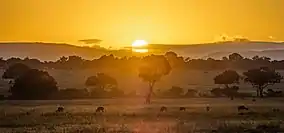 Typical "spotted" Maasai Mara scenery | |
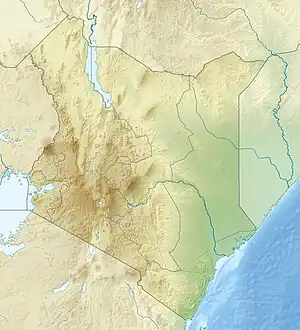 Location of Maasai Mara National Reserve | |
| Location | Kenya, Rift Valley Province |
| Nearest town | Narok |
| Coordinates | 1°29′24″S 35°8′38″E / 1.49000°S 35.14389°E |
| Area | 1,510 km2 (580 sq mi)[1] |
| Established | 1961 |
| Governing body | Narok County |
Maasai Mara, also sometimes spelled Masai Mara and locally known simply as The Mara, is a large national game reserve in Narok, Kenya, contiguous with the Serengeti National Park in Tanzania. It is named in honour of the Maasai people, the ancestral inhabitants of the area, who migrated to the area from the Nile Basin. Their description of the area when looked at from afar: "Mara" means "spotted" in the local Maasai language, due to the many short bushy trees which dot the landscape.
Maasai Mara is one of the wildlife conservation and wilderness areas in Africa, with its populations of lion, leopard, cheetah and African bush elephant. It also hosts the Great Migration, which secured it as one of the Seven Natural Wonders of Africa, and as one of the ten Wonders of the World.
The Greater Mara ecosystem encompasses areas known as the Maasai Mara National Reserve, the Mara Triangle, and several Maasai Conservancies, including Koiyaki, Lemek, Ol Chorro Oirowua, Mara North, Olkinyei, Siana, Maji Moto, Naikara, Ol Derkesi, Kerinkani, Oloirien, and Kimintet.
History
When it was originally established in 1961 as a wildlife sanctuary the Mara covered only 520 km2 (200 sq mi) of the current area, including the Mara Triangle. The area was extended to the east in 1961 to cover 1,821 km2 (703 sq mi) and converted to a Game Reserve. The Narok County Council (NCC) took over management of the reserve at this time. Part of the reserve was given National Reserve status in 1974, and the remaining area of 159 km2 (61 sq mi) was returned to local communities. An additional 162 km2 (63 sq mi) were removed from the reserve in 1976, and the park was reduced to 1,510 km2 (580 sq mi) in 1984.[2]
In 1994, the TransMara County Council (TMCC) was formed in the western part of the reserve, and control was divided between the new council and the existing Narok County Council. In May 2001, the not-for-profit Mara Conservancy took over management of the Mara Triangle which covers the western part of the reserve.[2]
The Maasai people make up a community that spans across northern, central and southern Kenya and northern parts of Tanzania. As pastoralists, the community holds the belief that they own all of the cattle in the world. The Maasai rely on their lands to sustain their cattle, as well as themselves and their families. Prior to the establishment of the reserve as a protected area for the conservation of wildlife and wilderness, the Maasai were forced to move out of their native lands.
Tradition continues to play a major role in the lives of modern-day Maasai people, who are known for their tall stature, patterned shukas and beadwork. It is estimated that there are approximately half a million individuals[3] that speak the Maa language and this number includes not only the Maasai but also Samburu and Camus people in Kenya.
Geography

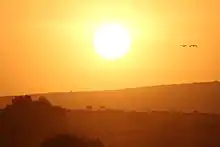
The total area under conservation in the Greater Maasai Mara ecosystem amounts to almost 1,510 km2 (580 sq mi).[1] It is the northernmost section of the Mara-Serengeti ecosystem, which covers some 25,000 km2 (9,700 sq mi) in Tanzania and Kenya. It is bounded by the Serengeti Park to the south, the Siria / Oloololo escarpment to the west, and Maasai pastoral ranches to the north, east and west. Rainfall in the ecosystem increases markedly along a southeast–northwest gradient, varies in space and time, and is markedly bimodal. The Sand, Talek River and Mara River are the major rivers draining the reserve. Shrubs and trees fringe most drainage lines and cover hillslopes and hilltops.
The terrain of the reserve is primarily open grassland with seasonal riverlets. In the south-east region are clumps of the distinctive acacia tree. The western border is the Esoit (Siria) Escarpment of the East African Rift, which is a system of rifts some 5,600 km (3,500 mi) long, from Ethiopia's Red Sea through Kenya, Tanzania, Malawi and into Mozambique. Wildlife tends to be most concentrated here, as the swampy ground means that access to water is always good, while tourist disruption is minimal. The easternmost border is 224 km (139.2 mi) from Nairobi, and hence it is the eastern regions which are most visited by tourists.
It has a semi-arid climate with biannual rains and two distinct rainy seasons. Local farmers have referred to these as the 'long rains' which last approximately six to eight weeks in April and May and the 'short rains' in November and December which last approximately four weeks.
Elevation: 1,500–2,180 m (4,920–7,150 ft); Rainfall: 83 mm (3.3 in)/month; Temperature range: 12–30 °C (54–86 °F)
Wildlife



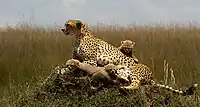
Blue wildebeest, topi, plains zebra and Thomson's gazelle migrate into and occupy the Mara reserve, from the Serengeti plains to the south and Loita Plains in the pastoral ranches to the north-east, from July to October or later. Herds of all three species are also resident in the reserve.
All members of the "Big Five" – lion, African leopard, African bush elephant, African buffalo, black and white rhinos – are found here all year round.[4] The population of black rhinos was fairly numerous until 1960, but it was severely depleted by poaching in the 1970s and early 1980s, dropping to a low of 15 individuals. Numbers have been slowly increasing, but the population was still only up to an estimated 23 in 1999.[5] The Maasai Mara is the only protected area in Kenya with an indigenous black rhino population, unaffected by translocations, and due to its size, is able to support one of the largest populations in Africa.[6]
Hippopotamuses and Nile crocodiles are found in large groups in the Mara and Talek rivers. The plains between the Mara River and the Esoit Siria Escarpment are probably the best area for game viewing, in particular regarding lion and cheetah.
There are many large carnivores found here in the reserve. Lions are the most dominant and are found here in large numbers. Spotted hyenas are another abundant carnivore, and will often compete with lions for food. Leopards are found anywhere in the reserve where there are trees for them to escape to. East African cheetahs are also found in high numbers on the open savanna, hunting gazelles and wildebeest. African wild dogs are quite rare here due to the widespread transmission of diseases like canine distemper and the heavy competition they face with lions, who can often decimate their populations. Their packs also roam around a lot and travel far distances throughout the plains, making it hard to track them. Smaller carnivores that don't directly compete with the latter include African wolves, black-backed jackals, African striped weasels, caracals, servals, honey badgers, aardwolves, African wildcats, side-striped jackals, bat-eared foxes, Striped polecats, African civets, genets, several mongoose species, and African clawless otters.
Wildebeest are the dominant inhabitants of the Maasai Mara, and their numbers are estimated in the millions. Around July of each year, these animals migrate north from the Serengeti plains in search of fresh pasture, and return to the south around October. The Great Migration is one of the most impressive natural events worldwide, involving some 1,300,000 blue wildebeest, 500,000 Thomson's gazelles, 97,000 topi, 18,000 common elands, and 200,000 Grant's zebras.[7]
Antelopes can be found, including Grant's gazelles, impalas, duikers and Coke's hartebeests. The plains are also home to the distinctive Masai giraffe. The large roan antelope and the nocturnal bat-eared fox, rarely present elsewhere in Kenya, can be seen within the reserve borders.
More than 470 species of birds have been identified in the park, many of which are migrants, with almost 60 species being raptors.[8] Birds that call this area home for at least part of the year include: vultures, marabou storks, secretary birds, hornbills, crowned cranes, ostriches, long-crested eagles, African pygmy-falcons and the lilac-breasted roller, which is the national bird of Kenya.
Administration
The Maasai Mara is administered by the Narok County government. The more visited eastern part of the park known as the Maasai Mara National Reserve is managed by the Narok County Council. The Mara Triangle in the western part is managed by the Trans-Mara county council, which has contracted management to the Mara Conservancy since the early 2000s.[9]
The outer areas are conservancies that are administered by Group Ranch Trusts of the Maasai community, although this approach has been criticised for benefitting just a few powerful individuals rather than the majority of landowners.[10] Although there has been a rise in fencing on private land in recent years,[11] the wildlife roam freely across both the reserve and conservancies.
Research
The Maasai Mara is a major research centre for the spotted hyena. With two field offices in the Mara, the Michigan State University based Kay E. Holekamp Lab studies the behaviour and physiology of this predator, as well as doing comparison studies between large predators in the Mara Triangle and their counterparts in the eastern part of the Mara.[12]
A flow assessment and trans-boundary river basin management plan between Kenya and Tanzania was completed for the river to sustain the ecosystem and the basic needs of 1 million people who depend on its water.[13]
The Mara Predator Project also operates in the Maasai Mara, cataloging and monitoring lion populations throughout the region.[14] Concentrating on the northern conservancies where communities coexist with wildlife, the project aims to identify population trends and responses to changes in land management, human settlements, livestock movements and tourism.
Since October 2012, the Mara-Meru Cheetah Project[15] has worked in the Mara monitoring cheetah population, estimating population status and dynamics, and evaluating the predator impact and human activity on cheetah behavior and survival. The head of the Project, Elena Chelysheva, was working in 2001–2002 as Assistant Researcher at the Kenya Wildlife Service (KWS) Maasai-Mara Cheetah Conservation Project. At that time, she developed original method of cheetah identification based on visual analysis of the unique spot patterns on front limbs (from toes to shoulder) and hind limbs (from toes to the hip), and spots and rings on the tail.[16] Collected over the years, photographic data allows the project team to trace kinship between generations and build Mara cheetah pedigree. The data collected helps to reveal parental relationship between individuals, survival rate of cubs, cheetah lifespan and personal reproductive history.
The resilience of the game park model and the impact of the covid pandemic have also been evaluated so as to include consideration of issues of equality, and environmentalism.[17]
Tourism
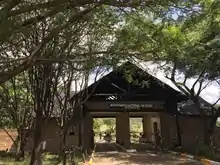
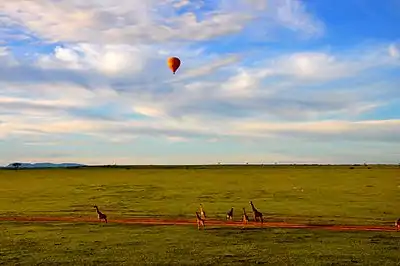
The Maasai Mara is one of the most famous safari destinations in Africa.[18] Entry fees are currently US$ 70 for adult non-East African Residents per 24 hours (if staying at a property inside the Reserve) or US$80 if outside the reserve, and $40 for children.[19] There are a number of lodges and tented camps catering for tourists inside or bordering the Reserve and within the various separate Conservancies which border the main reserve. However, the main reserve is unfenced even along the border with Serengeti (Tanzania) which means there is free movement of wildlife throughout the ecosystem.
Although one third of the whole Maasai Mara in the western part of the larger reserve, The Mara Triangle has only two permanent lodges within its boundaries, namely the Mara Serena Lodge and Little Governors Camp (compared to the numerous camps and lodges on the Narok side) and has well maintained, all weather gravel roads. The rangers patrol regularly which means that there is less poaching and excellent game viewing. There is also strict control over vehicle numbers around animal sightings, allowing for a better experience when out on a game drive. Most lodges within the region charge higher rates during the Migration season, although the Maasai Mara is home to prolific wildlife year-round.
There are several airfields which serve the camps and lodges in the Maasai Mara, including Mara Serena Airstrip, Musiara Airstrip and Keekorok, Kichwa Tembo, Ngerende Airport, Ol Kiombo and Angama Mara Airstrips, and several airlines such as SafariLink and AirKenya fly scheduled services from Nairobi and elsewhere multiple times a day. Helicopter flights over the reserve are limited to a minimum height of 1,500 ft.
Game drives are the most popular activity in the Maasai Mara, but other activities include hot air ballooning, nature walks, photographic safaris and cultural experiences.
Big Cat Diary
The BBC Television show titled "Big Cat Diary" was filmed in the Maasai Mara.[20] The show followed the lives of the big cats living in the reserve. The show highlighted scenes from the Reserve's Musiara marsh area and the Leopard Gorge, the Fig Tree Ridge areas and the Mara River, separating the Serengeti and the Maasai Mara.
Photography competition
In 2018, the Angama Foundation, a non-profit affiliated with Angama Mara, one of the Mara's luxury safari camps, launched the Greatest Maasai Mara Photographer of the Year competition, showcasing the Mara as a year-round destination and raise funds for conservation initiatives active in the Mara.[21] The inaugural winner was British photographer Anup Shah.[22] The 2019 winner was Lee-Anne Robertson from South Africa.[23]
Threats
A study funded by WWF and conducted by ILRI between 1989 and 2003 monitored hoofed species in the Mara on a monthly basis, and found that losses were as high as 75 percent for giraffes, 80 percent for common warthogs, 76 percent for hartebeest, and 67 percent for impala. The study blames the loss of animals on increased human settlement in and around the reserve. The higher human population density leads to an increased number of livestock grazing in the park and an increase in poaching. The article claims, "The study provides the most detailed evidence to date on the declines in the ungulate (hoofed animals) populations in the Mara and how this phenomenon is linked to the rapid expansion of human populations near the boundaries of the reserve."[24]
The rise of local populations in areas neighbouring the reserve has led to the formation of conservation organisations such as the Mara Elephant Project who aim to ensure the peaceful and prosperous co-existence of humans alongside wildlife. Human wildlife conflict is seen as a leading threat to the reserve as the population continues to grow.[25]
See also
References
- 1 2 Protected Planet (2018). "Masai Mara". United Nations Environment World Conservation Monitoring Centre. Archived from the original on 2 January 2019. Retrieved 6 August 2015.
- 1 2 Walpole 2003, p. X
- ↑ "Maa Language,University of Oregon". University of Oregon, Doris.L.Payne. Archived from the original on 10 December 2019. Retrieved 4 May 2020.
- ↑ "About the Masai Mara National Reserve | National Geographic Lodges". National Geographic Unique Lodges of the World. Archived from the original on 23 August 2017. Retrieved 23 August 2017.
- ↑ Walpole 2003, p. 17
- ↑ "Black Rhino". Mara Conservancy. Archived from the original on 7 April 2020. Retrieved 7 April 2020.
- ↑ "The Greatest Show on Earth". The Mara Conservancy. Archived from the original on 19 October 2010. Retrieved 17 October 2010.
- ↑ "Bird List". maratriangle.org. The Mara Conservancy. Archived from the original on 7 March 2016. Retrieved 16 June 2020.
- ↑ "The Story of the Mara Triangle". Angama. 14 February 2017. Archived from the original on 12 August 2020. Retrieved 4 May 2020.
- ↑ "The Greater Mara Ecosystem". Maasai Mara Wildlife Conservancies Association. 21 May 2017. Archived from the original on 4 August 2020. Retrieved 4 May 2020.
- ↑ "March 2020". Mara Conservancy. Archived from the original on 24 March 2023. Retrieved 4 May 2020.
- ↑ "Research". The Mara Conservancy. Archived from the original on 17 October 2010. Retrieved 17 October 2010.
- ↑ McClain, M.E.; Subalusky, A.L.; Anderson, E.P.; Dessu, S.B.; Melesse, A.M.; Ndomba, P.M.; Mtamba, J.O.; Tamatamah, R.A.; Mligo, C. (2014). "Comparing flow regime, channel hydraulics, and biological communities to infer flow–ecology relationships in the Mara River of Kenya and Tanzania". Hydrological Sciences Journal. 59 (3−4): 801−819. doi:10.1080/02626667.2013.853121. S2CID 129652372.
- ↑ "Mara Predator Project". Archived from the original on 2 March 2012. Retrieved 1 February 2012.
- ↑ "Mara Meru Cheetah Project". marameru.org. Archived from the original on 23 December 2017. Retrieved 22 December 2017.
- ↑ "Cat News #41, 2004". Archived from the original on 28 December 2011. Retrieved 23 March 2014.
- ↑ Shreya Chakrabarti The sensitivity of the Maasai Mara Conservancy Model to external shocks (2021) https://uu.diva-portal.org/smash/record.jsf?pid=diva2%3A1567539&dswid=-2405 Retrieved 30 September 2021
- ↑ Shah, Anisha (10 February 2014). "10 Best Safari Destinations in Africa". Fodors Travel Guide. Archived from the original on 16 November 2020. Retrieved 4 May 2020.
- ↑ "The Mara Conservancy – Park fees". maratriangle.org. Mara Conservancy. Archived from the original on 8 January 2010. Retrieved 3 November 2009.
- ↑ Holmwood, Leigh (17 July 2008). "Big Cat Live: BBC to film lions, cheetahs and leopards in Kenyan reserve". The Guardian. ISSN 0261-3077. Retrieved 7 June 2023.
- ↑ "The Greatest Maasai Mara Photographer of the Year". Angama Foundation. Archived from the original on 18 January 2022. Retrieved 17 June 2020.
- ↑ "The greatest Maasai Mara Photographer of the year winner announcement". Nomad. 2018. Archived from the original on 12 August 2019. Retrieved 12 August 2019.
- ↑ "Maasai Mara 2019 Photographer of the Year announced". Tourism Update. 2019. Archived from the original on 5 December 2019.
- ↑ Ogutu, J. O.; Piepho, H. P.; Dublin, H. T; Bhola, N.; Reid, R. S. (May 2009). "Dynamics of Mara-Serengeti ungulates in relation to land use changes". Journal of Zoology. 278 (1): 1–14. doi:10.1111/j.1469-7998.2008.00536.x.
- ↑ "Our Mission". Mara Elelphant Project. Archived from the original on 12 August 2019. Retrieved 12 August 2019.
Works cited
- Walpole, M.; Karanja, G.G.; Sitati, N.W.; Leader-Williams (2003). Wildlife and People: Conflict and Conservation in Masai Mara, Kenya (PDF) (Report). Wildlife and Development Series. Vol. 14. London: International Institute for Environment and Development. ISBN 978-1-84369-416-8. Archived from the original (PDF) on 18 January 2006.